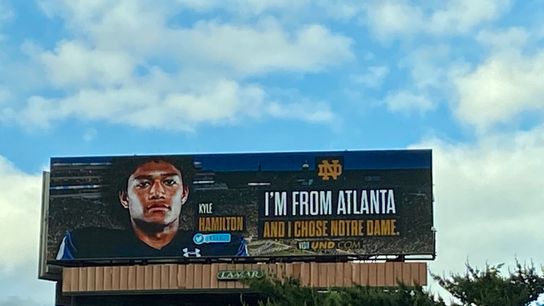The internal unveiling caused a bit of a rush for cell phones.
Inside Notre Dame's trophy-laden Guglielmino Athletics Complex, home to the Heisman trophies of the program's seven winners, among myriad other hardware, high-def television screens feature what players initially believe simply are graphics advertising members of the Fighting Irish football team and spotlighting their hometowns.
Notre Dame coach Brian Kelly, 11 seasons at the helm and three times playing for a national championship, is the culprit.
“Coach Kelly had the idea of taking what we were putting on billboards across the country and putting that throughout the TVs in the football building,” Irish defensive line coach and recruiting coordinator Mike Elston tells FootballScoop. “The players all showed up and saw it in the locker room. There was a buzz, an energy, but the guys at first just thought it was graphics we were using. We said, 'No, those are actual billboards up active in their home areas.'
“Pretty soon they were all on the phone with their families, calling. They were excited there were actual billboards with their faces. It was cool to see their reaction and to know we support them. It's important for us to help them with the growth of their brand and social media accounts.”
Thursday, Notre Dame formally launched its nationwide billboard campaign targeted to both raise the individual profiles of its players – each billboard features a player's Twitter handle – and amplify recruiting visibility as the NCAA's 15-month COVID-induced dead period has almost arrived.
The Irish launched the billboards in Atlanta, Chicago, Cincinnati, Dallas, Detroit, Indianapolis, Los Angeles, New York City/Jersey City, Phoenix, Pittsburgh, St. Louis, Tampa and the Washington, D.C. area known as the DMV.
Star safety Kyle Hamilton, already a projected top-10 pick in the 2022 NFL Draft, is featured prominently in Atlanta; tailback Kyren Williams, off a breakout-season, is featured in St. Louis. There are offensive linemen, defensive backs and additional players quite literally from coast to coast.
“It started off as we wanted to, Coach Kelly charged our staff, to create a virtual spring recruiting plan,” says Elston, at Notre Dame with Kelly since 2010. “What we're doing is we are getting into recruiting areas, rather than just spending so much focus on positional recruiting, which we've been doing quite often here. We said, 'How do we get further into those areas? How do we make it known that we're nationally recruiting and have had success with our national recruiting?'
“The recruiting team came up with the idea to put our players from areas on billboards through the country. We've got 13 major cities we chose, and we put multiple players on those. Some cities have eight-nine-10 players either from that state or that city.”
Notre Dame's proactive approach to embracing more individual marketing ahead of pending name, image and likeness legislation unfolding to give student-athletes power to earn money during their playing careers sends a strong message, according to The Spyre Sports Group's James Clawson.
“I think first of all it conveys that Notre Dame is saying, 'We are serious about NIL, serious about our players and serious about our players' brands,'” says Clawson, who's negotiated multiple NFL, PGA and collegiate marketing agreements and has brokered multiple pending NIL pacts. “It says we're investing in NIL. Over time, this is going to truly create significant value for student-athletes at Notre Dame. Who are the donors in those areas (of the billboards)? What are the businesses they own? Are they in positions of power to make decisions in marketing?
“These decisions can help with really leveraging those relationships and creating a buzz that builds over time. Maybe you don't get your top kid a deal in, say, the St. Louis market this year, but all you're doing is setting yourself up for great success, a great foundation for the future.”
Exactly how much power – and ultimately revenue – student-athletes are going to potentially earn from the name, image and likeness revolution is an ongoing debate. Schools have their own marketing brands, sometimes from the school's official airlines partner to its headset-sponsor on the sidelines.
“It's extremely critical; it's going to be a new era of the student-athlete,” Elston says. “You and I both know the No. 1 way to strengthen your brand is performance in the arena, but then playing well in football, basketball or whatever the sport these student-athletes are in, the co-branding they choose, they need to be strategic. Because it can elevate to life after football.
“We have numerous examples that we show to guys when we're recruiting of players that have gone on and done things outside of football after graduating from the University of Notre. This thing doesn't just go regional, local or national for us at Notre Dame; it goes global for us.”
Players' first is a path Clawson believes is key for programs moving forward.
“I think we're going to really find out the schools, especially over the next year, that are forward-thinking versus not thinking that way at all,” Clawson says. “Schools putting twitter handles on backs of jerseys, billboards in these major markets, really putting players out in front of the school instead of the school logo being first thing you see.
“I think schools need to err on the side of what is in the best interest of the player, the student-athlete. If you do that, I think the long-term health of your athletic department is going to be really good.”
